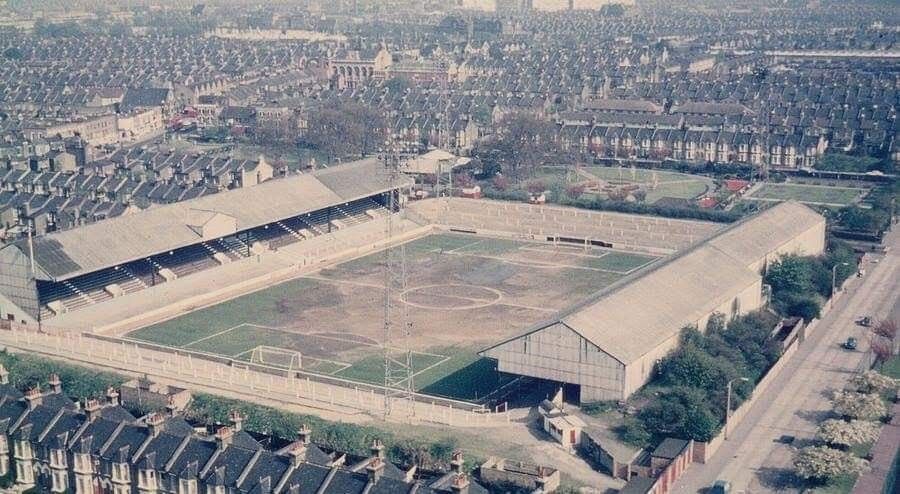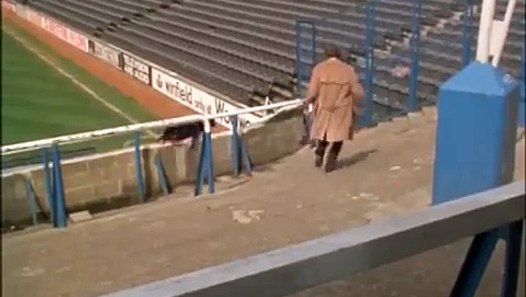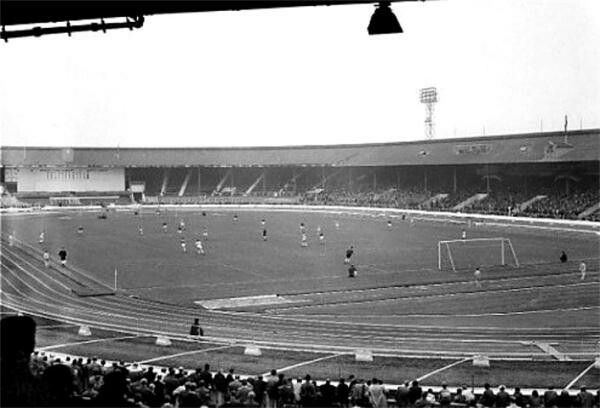Post-War London – Villains: The Football League on Film
London football grounds were an ideal location for post-War film and TV drama, their stands and terraces the perfect setting for crooks, spivs and villains.

Orient’s Brisbane Road was used for a key scene in 1967’s Robbery. Based on the Great Train Robbery, Stanley Baker leads the gang planning an audacious armed robbery, who meet on Brisbane Road’s North Terrace to discuss the logistics of their operation. The scene was filmed at Orient’s Third Division game against Swindon Town on 1 April 1967 (a goalless draw), with the home team in the blue kit. The club’s colours were changed from blue, which they had worn since becoming Leyton Orient in 1946, back to their original red the following season (they dropped ‘Leyton’ in 1966 but it was restored in 1987).
The ugly side of 1970s football was seen in Made (1972), a gritty drama starring Carol White and singer Roy Harper. The film featured QPR match footage at Loftus Road (at 56:53) – the game is unidentified but Gerry Francis and Terry Mancini can be seen, probably during the 1971-72 season. There are also scenes of crowd violence depicted outside the ground, typical of the era. In a more light-hearted vein, an episode of the long-running prison comedy Porridge revolved around buried treasure at Elland Road. The crucial scene of ‘Happy Release’ in fact used Loftus Road instead. Popular police series The Sweeney frequently explored London’s seamier side, and the 1975 episode ‘I want the man’ saw DI Jack Regan, memorably played by John Thaw, pursue a ‘grass’ through QPR’s deserted stadium.

The Sweeney, Loftus Road 
Minder, Stamford Bridge
Thaw’s Sweeney co-star Dennis Waterman, a keen football fan, went on to star in Minder, and the game featured frequently. Playing the title character Terry McCann, Waterman was seen standing on the terraces at Stamford Bridge in a 1980 episode (‘All about scoring, innit?’). The match footage was of Chelsea v Preston North End, a 1-1 draw on 20 September 1980.
Brentford’s Griffin Park had been a filming location before the Second World War and was used again post-War, later in the Minder series. As an article on Jimmy Sirrel’s Lovechild explains, ‘The long ride back to Scratchwood’ “includes extensive footage of the Royal Oak End and, poignantly, the southern section of the Braemar Road Stand which burned down between the episode’s filming and its broadcast.” Wembley Stadium figured prominently alongside Brentford’s former home in this tale of a crooked player and black-market tickets, broadcast in 1984.
Wembley also provided a backdrop to Quatermass (1979), as the national stadium got an unusual treatment in this late-70s dystopian take on a long-running British sci-fi series. A four-part serial culminated in cult members, awaiting the apocalypse with the country in ruins, gathering at the home of English football under the famous Twin Towers.
White City Stadium was built as the primary venue for the 1908 London Olympic Games. With an impressive capacity of close to 100,000 at one time, it hosted many sports until its demolition in 1985. Together with the group game between France and Uruguay at the 1966 World Cup, the stadium served as QPR’s home ground for several spells, playing their first game there when a Southern League club in 1912. As a film location, it made an early post-War appearance in 1950’s crime drama The Blue Lamp, which concluded with villain Dirk Bogarde being chased into the stadium. It was later used for the spy series Man in a Suitcase (as ‘Regal City Stadium’ in the 1967 episode ‘Man from the Dead’). In its main role as a greyhound racing venue, White City Stadium was a backdrop to Jumping for Joy (1956) and Steptoe and Son Ride Again (1973).

With thanks to https://www.minder.org/ for episode information and stills.



